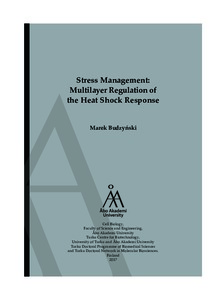Stress management: multilayer regulation of the heat shock response
Budzyński Marek Andrzej
https://urn.fi/URN:NBN:fi-fe2021042716969
Tiivistelmä
Protein-damaging stresses, such as exposure to elevated temperature, alcohol, and heavy metals and microbial infections, increase the amount of misfolded proteins in cells, which may lead to formation of toxic protein aggregates. In order to counteract detrimental effects of proteotoxic stresses, all organisms have developed a specific response, called the heat shock response (HSR). Upon the HSR activation, synthesis of heat shock proteins (HSPs) increases. HSPs function as molecular chaperones to aid in the refolding of misfolded proteins and prevent formation of protein aggregates. The inducible expression of HSP genes is mediated by heat shock factors (HSFs). Mounting the HSR involves trimerization, nuclear accumulation, gain of DNA-binding and transactivation capacity of HSF1 and coincides with extensive post-translational modifications of HSF1. However, the importance of these modifications on HSF1 activity has remained elusive. This PhD thesis describes the functional impact of stress-inducible phosphorylation of HSF1 on the HSR. While HSF1 phosphorylation upon stress is not required for the HSR activation, it defines the onset of the HSR and fine-tunes the magnitude of the response. Moreover, a chaperone co-inducer BGP-15 was found to augment the HSR, due to its ability to inhibit histone deacetylases (HDACs). BGP-15 as an HDAC inhibitor increases chromatin accessibility at multiple genomic loci including HSP genes and accelerates HSF1 activation in the event of proteotoxic stress. Furthermore, HDAC inhibitors can function as chaperone co-inducers and have cytoprotective effect for cells exposed to stress. Taken together, this study provides valuable information on molecular mechanisms regulating the HSR, which can serve as a basis for further development of pharmaceuticals aimed to activate, enhance or repress the HSR.
Kokoelmat
- Rinnakkaistallenteet [19218]
